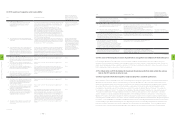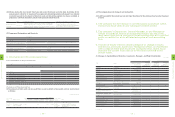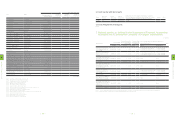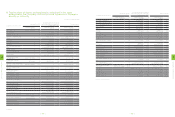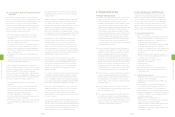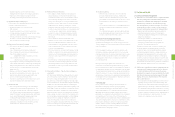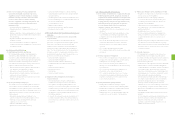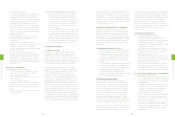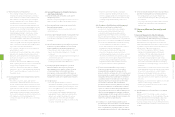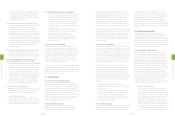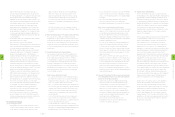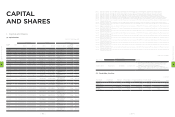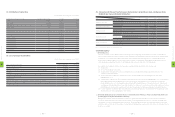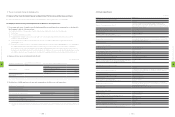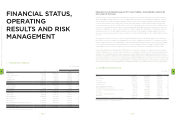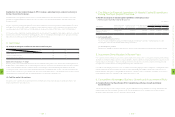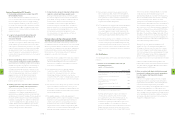HTC 2011 Annual Report Download - page 47
Download and view the complete annual report
Please find page 47 of the 2011 HTC annual report below. You can navigate through the pages in the report by either clicking on the pages listed below, or by using the keyword search tool below to find specific information within the annual report.
gases produced in connection with those products occurs
during this stage. For that reason HTC gives intense scrutiny
during research and development to the question of energy
efficiency. As a part of our concern for energy efficiency,
the power supplies for all HTC product must conform to
international energy use standards, including the US EPA
Energy Star program, the California Energy Commission
standards, the EU Code of Conduct, and the EU EuP Directive.
In addition, our R&D team has developed outstanding power
management systems. Based on consumer habits, handsets
automatically switch to energy-saving mode that reduces
energy use and extends battery life. Some models also include
light sensors that trigger an automatic LCD backlighting
function, which not only creates more readable displays but
also saves energy.
6-3. Design for recyclability
The actual recycling rate for HTC mobile phones, including
reuse and recovery rates and recycling and recovery rates, far
exceeds the requirements of the EU WEEE (Waste Electrical
and Electronic Equipment) standards. HTC also performs
risk assessments in the areas of the disabling injury rate and
severity rate, on the basis of which it adopts corresponding
measures to reduce the number of accidents resulting from
production processes, equipment, and environments, and
the number of harmful exposures to chemical products.
HTC makes design-for-recyclability assessments and other
simulations part of its initial research and development. It
disassembles products and performs material simulations
to estimate materials compositions and recycling rates.
Labeling of materials, simplified component design, and
design for ease of disassembly are strategies used to provide
feedback on designs to the R&D team. Current HTC products
are designed to meet both current and future recycling
standards.
• The corrugated board HTC uses as mobile phone
packaging material is manufactured from more than 90%
recycled paper.
• If the use of virgin materials cannot be avoided because
of visual design considerations, the packaging materials
used will have received certification from the FSC
(Forest Stewardship Council), PEFC (Programme for the
Endorsement of Forest Certification schemes), or SFI
(Sustainable Forestry Initiative).
6-4. Low-Toxicity Design
As early as 2005, HTC had already produced the world's first
PDA phone to meet the standards of the EU's RoHS Directive
(Restriction on the Use of Certain Hazardous Substances
in Electrical and Electronic Equipment). From that time to
the present, HTC has required that all parts, modules, and
materials delivered to its plants conform with its substances
control checklist. Its control of restricted substances
goes beyond the six controlled substances listed in the
RoHS Directive to include other items deemed controlled
substances in accordance with international environmental
laws and regulations or the requirements of our international
customers.
(7) Public Welfare Activities
HTC puts great effort into environmental protection,
health and safety, energy management, and providing and
maintaining a safe and healthy working environment for its
workers. Through the HTC Foundation it promotes character-
building educational activities for children and young people.
HTC also takes part in blood donation drives, employs persons
with disabilities, and takes part in community environmental
clean-up efforts in mountain and seaside areas.
7-1. Promoting Character Education
In recent years, HTC Foundation has been involved with
promoting character-building education for children and
young people, working together with city and community
efforts to create a culture of character and showing concern
for disadvantaged groups by providing extra educational
opportunities for their children. In addition to providing
programs to encourage continuing study, HTC also works
tirelessly with others to help promote a culture of values
which will foster individuals who are upright, honest, caring,
positive and concerned about natural resources. HTC
Foundation is continuing a three-year project it began in
March of 2008 when it signed a "character white paper" with
the Taoyuan County Government to create "100 character-
building schools." HTC promotes character education
in all areas among educational administrators, schools,
communities, and families, as part of its effort to establish a
network for the promotion of character education.
Substantive accomplishments:
• HTC continues to contribute to the establishment
of its Character and English Institute in Hualien
County's Ji'an Township, providing full sponsorship
for attendance by nearly 2,000 4th-grade elementary
school students from throughout Hualien County at
a five-day, four-night camp for character building
and English skills. Each year HTC contributes tens of
millions of New Taiwan Dollars in sponsorship for all
operating and upkeep costs, while also participating in
development of courses that provide English teaching
to the disadvantaged and residents of remote areas.
• HTC, in cooperation with Yunlin County Government
• HTC has installed time-controlled lighting between
floors in office working areas and infrared sensor
lighting switches to effectively reduce electricity
consumption through automatic detection and time-
controlled lighting measures.
(3) Overall Management of Air Conditioning Systems
To manage repair and maintenance of air conditioning
systems and their levels of efficiency, HTC has
established environmental operation management
principles for air conditioning systems and carried out
appraisal and review of the air conditioning equipment
and ductwork. Further, through continuing monitoring,
measurement, and improvement of energy use under
the ISO 50001 system, HTC in 2011 was able to improve
its systems and achieve an increase in energy efficiency
from 1.53 KW/RT to 0.88 KW/RT, allowing for annual
savings of nearly 3 million KW per year from the air
conditioning system.
(4) Energy Reduction Management in Hot Water Systems
In 2011 electrically heated hot water systems were
upgraded to air-source heat pump water heater, resulting
in an annual CO2 reduction of 1.2 metric tons of CO2e.
5-2. Use and Management of Water Resources
(1) Wastewater Reuse Rates Enhanced Through
Wastewater Treatment and Self-built Treatment Facility
The primary sources of plant wastewater derive from
general domestic and dining facility wastewater and
employee restroom and cleaning uses. To thoroughly
resolve any adverse impacts from waste or polluted
water on nearby receiving water bodies, HTC's water
treatment facility has operated at a peak daily capacity
of 200 metric tons of recycled water since July 2011,
producing water which can be used for irrigation in
the industrial park area or for urinal flushing, thereby
reducing the use of water from the mains system.
(2) Rainwater Recycling Management
Rainwater collection and filtration for daily use in urinal
flushing, irrigation, and fire prevention water storage
reduces the use of water from the mains system.
(3) Use of Water-Saving Devices
Water-saving devices have been installed in break
rooms, shower rooms and restrooms, and reduced-flow
faucets and two-stage flushing systems in restrooms
help reduce wastage and the volume of water used.
5-3. Other Energy and Resource Management
• Paper consumption has been greatly reduced by using
electronic substitutes for general workflow (including
electronic bulletin boards, online education and
training, and E-forms for reservation of meeting and
conference rooms, leave requests, name-card orders,
and overtime requests), along with the installation
of advanced electronic whiteboards and whiteboard
projection screens.
• External faxes are not printed out, but are all sent
as electronic files to the recipient person or unit to
reduce the need for photocopying.
• Whenever possible HTC uses recycled paper
packaging for any items it must send by express
deliveries, and avoids using plastic envelopes that
cannot be recycled.
5-4. Promoting Green Buildings
During the planning of its new facilities in Xindian and
Taoyuan, HTC's goals were to apply for and be recognized
as meeting the standards of the U.S. Green Building Council
(USGBC) and to receive certification at the gold certification
level under the LEED (Leadership in Energy & Environmental
Design) system, and to observe those same criteria in the
future construction of its new plant, in order to construct a
comfortable, healthy, environmental, energy-efficient, and
water-conserving working environment.
To achieve these goals, the LEED requirements were reflected
during all phases of the planning, design, and construction of
the project, and engineering contractors in all areas were also
required to fully reflect the relevant LEED requirements in all
aspects of their construction work.
(6) Green Products
6-1. Green Products and Supply Chain
HTC promotes a green supply chain and puts its full
resources behind producing green products. This means
attention to each phase of production, from initial design and
manufacturing to later use and end-of-life considerations,
accommodating design for environment issues and producing
a variety of green products conceived on the basis of their
energy-saving, recyclable, and low-toxic qualities. HTC does its
best to avoid the use of harmful substances during production
to ensure its products meet international environmental
standards while satisfying its customers' needs.
6-2. Energy-efficient designs
In the overall life cycle of an electronic communications
product, the most energy-intensive period is the period
of use by the consumer, meaning that most greenhouse
4
CORPORATE GOVERNANCE
| 90 |
4
CORPORATE GOVERNANCE
| 91 |


